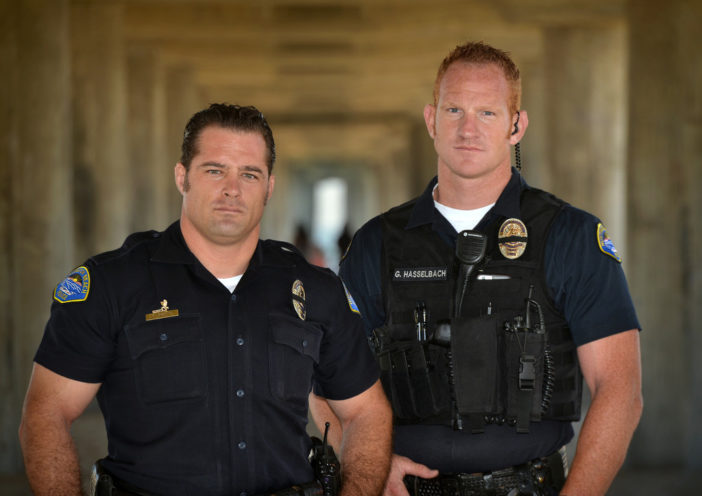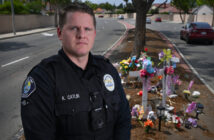Editor’s note: In honor of Behind the Badge OC’s one-year anniversary, we will be sharing the 30 most-read stories. No. 28 from Huntington Beach was originally published April 9.
It started as a somewhat typical drunken driving arrest on a rainy night in December 2012.
Officer Grant Hasselbach and other officers were pursuing a man who would not pull over on the southbound 125 in San Diego County.
After the suspect finally pulled to the shoulder, Hasselbach, an officer with El Cajon PD at the time, handcuffed the man and escorted him to the police car.
Hasselbach was trying to help the suspect into the car when he looked up.
The next split-second seemed to happen in slow motion.
“I remember I was trying to get the guy’s foot in the car, and I look at (my partner) and his eyes are wide open,” he said. “I just saw two headlights screaming at me.”
His partner pulled him out of way and Hasselbach grabbed the suspect an instant before the white Nissan smashed into the back of the police cruiser.
The woman driving the Nissan was arrested on suspicion of drunken driving, along with the guy Hasselbach pulled out of the way.
That incident changed the way Hasselbach approached his law enforcement career.
“I just got fed up at that point and made it a goal to find and arrest drunken drivers,” Hasselbach said.
And he did.
In the four months following his near miss, he arrested nearly 50 people for driving intoxicated.
“I just started attacking the problem,” he said. “I took it to heart because I was almost killed.”
Now, three years later, Hasselbach is taking his efforts to the next level as one of the newest drug recognition experts with the Huntington Beach Police Department.
While all officers are trained to recognize an impaired driver, DREs take a more in-depth approach with intoxicated drivers.
“It’s just a more advanced level of recognizing symptoms in people we deal with on the street,” he said. “It is extra training that makes you a better, safer street cop.”
DRUG TRAINING
They start with the eyes.
The eyes are a dead giveaway that tells officers whether a person is intoxicated. They also divulge what substance that person took and even how much.
“The eyes will do different things on each of the drugs,” Hasselbach said. “The first thing I do when I talk to somebody is look at their pupils, and you can tell if they’ve taken something.”
If it’s dark out and the pupils are constricted, it signals a drug such as heroine or methadone. Dilated pupils on a bright day alert officers to stimulants such as cocaine or methamphetamine.
Although a suspect’s eyes are the first tell-tale sign of impairment, that is just one type of evaluation.
Officer Zach Pricer, a DRE who has been with HBPD for 12 years, also relies on his people skills to make the initial assessment.
“My thing is to get people talking,” he said. “I can evaluate their speech, their movement patterns, what their eyes are doing and their demeanor.
“I am interested in the behavioral aspect of it — how different substances affect the body, and as a DRE you delve into that.”
A suspect falling asleep mid-conversation can signal opiate use, while a person pacing the street and speaking quickly may mean they ingested a stimulant.
In some cases, Pricer said, officers need to be prepared for an evaluation that doesn’t signal drug use.
Sometimes erratic behavior can be the result of a person suffering from mental illness, which requires officers to tap into an entirely different skill set.
“It’s not only recognizing the person that’s under the influence, it’s also recognizing when a person is not under the influence,” Pricer said. “That’s just as important.”
After a field exam, suspects undergo an extensive evaluation back at the station.
DREs measure the suspect’s pupils, pulse rates, body temperature and blood pressure.
Based on the evaluation, the DRE will list one of seven drug categories they suspect the person to be under the influence of, which often is later confirmed by a blood test.
Every evaluation is always the same — that’s what makes the program successful, Pricer said.
“It has to be systematic, otherwise it doesn’t work,” he said. “We need to be fair and it wouldn’t be right if we did it any other way.”
COURT EXPERTS
Back in the 1990s, the DRE program was popular and growing in agencies across Orange County, but changes in how the Orange County District Attorney’s Office prosecuted DUI cases led to fewer officers going after their certification, said Detective Tim Emanuel, a DRE.
The pendulum is now swinging back the other way.
“Within the last few years, there has been an emphasis with the DA to bring DREs back,” Emanuel said. “With the number of people driving under the influence of marijuana on the rise, they need a DRE to help make (the charges) stick.”
DREs serve as expert witnesses in DUI cases, which Emanuel said are being challenged more often in court.
“Defense attorneys really hammer DUIs these days,” Emanuel said. “Your testimony can last for days.”
By tapping a DRE to attend court proceedings, the responsibility to provide testimony is taken off patrol officers.
A DRE’s testimony is lauded as an expert opinion in court because of the extensive training they have to go through and standards they must adhere to.
In Orange County, the Fullerton Police Department has led the charge in getting more officers certified, with more than one-third of its force achieving DRE status.
Officers from other agencies, including Huntington Beach, go to FPD to train, Emanuel said.
In Huntington Beach, the police department is beefing up its number of DREs and expects to have 15 certified officers come summertime.
DREs go through weeks of training and, at the end, must go on a three-day ride-along and evaluate 12 people suspected of being under the influence.
They need to predict the drug those 12 suspects are on with 90 percent accuracy.
After receiving certification, DREs are required to make at least four arrests a year where they use their skills to maintain their status.
“Even after you are certified, you have to constantly prove that you know what you’re doing,” Emanuel said.
Hasselbach said he expects to see more DRE officers in Huntington Beach and across Orange County in the coming years.
“We’ve had so many (alcohol or drug-related) traffic fatalities in the city, there is a huge push for DREs,” he said. “It’s just a good resource for the department and the courts, too.”
 Behind the Badge
Behind the Badge



